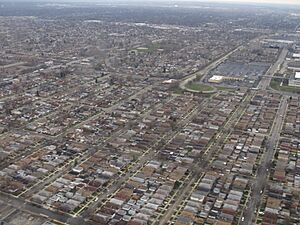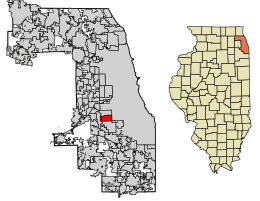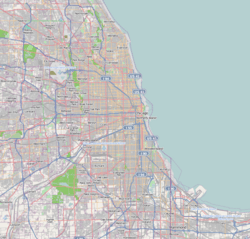Burbank, Illinois facts for kids
Quick facts for kids
Burbank, Illinois
|
|||
|---|---|---|---|

Aerial view of Burbank in November 2013
|
|||
|
|||

Location of Burbank in Cook County, Illinois.
|
|||
| Country | United States | ||
| State | Illinois | ||
| County | Cook | ||
| Township | Stickney | ||
| Incorporated | 1970 | ||
| Government | |||
| • Type | Mayor–council | ||
| Area | |||
| • Total | 4.17 sq mi (10.80 km2) | ||
| • Land | 4.17 sq mi (10.80 km2) | ||
| • Water | 0.00 sq mi (0.00 km2) | ||
| Elevation | 620 ft (190 m) | ||
| Population
(2020)
|
|||
| • Total | 29,439 | ||
| • Density | 7,059.71/sq mi (2,725.91/km2) | ||
| Time zone | UTC-6 (CST) | ||
| • Summer (DST) | UTC-5 (CDT) | ||
| ZIP code |
60459
|
||
| Area code(s) | 708 | ||
| FIPS code | 17-09642 | ||
| FIPS code | 17-09642 | ||
| GNIS feature ID | 422262, 2393465 | ||
Burbank is a city in Cook County, Illinois, United States. It is home to about 29,439 people, based on the 2020 census. Burbank is located right next to the southwest side of Chicago. Its eastern border touches Chicago's Ashburn neighborhood.
Burbank also shares borders with other towns. To its south is Oak Lawn. To the west, you'll find Bridgeview. Bedford Park is to the north. The city of Hometown is also very close, at Burbank's southeast corner. Plus, Chicago Midway International Airport is less than two miles south of Burbank.
Contents
History of Burbank
How Burbank Grew Over Time
In 1850, the area that is now Burbank was mostly empty farmland. It became part of Lyons Township. For the next 100 years, not much was built here. There were big plans for the area, but they never happened.
For example, in the late 1800s, a railroad investor named A. B. Stickney wanted to build a huge train center. This plan included the northern part of Burbank. But his ideas stopped because of a tough economic time in 1893.
Building Homes in Burbank
In the 1920s, people started to see the area as a good place for new homes. Developers bought farmland and planned neighborhoods. However, there were problems. The land often flooded, and there were almost no water or sewer systems. Also, the Great Depression made it hard to build. So, Burbank stayed mostly empty until the 1950s.
Becoming a City
In 1952, the area became part of Stickney Township. Even though it wasn't a city yet, this change led to a lot of building. By 1960, the number of people living there had grown a lot. The population reached 20,720, which was almost three times more than ten years before.
Burbank officially became a city in 1970. One reason was to avoid being taken over by the City of Chicago. The city was named after Luther Burbank Elementary School. This school had been serving the area since the 1930s. The population of Burbank reached its highest point in 1976, with 29,448 people.
Geography of Burbank
Burbank covers a total area of about 4.17 square miles (10.80 square kilometers). All of this area is land. There are no large bodies of water within the city limits.
Population and People
How Many People Live in Burbank?
According to the 2020 census, there are 29,439 people living in Burbank. There are 9,108 households, which are groups of people living together. About 6,823 of these are families.
The city has a mix of people from different backgrounds. Many different cultures and races make up the community. About 39.57% of the population identifies as Hispanic or Latino.
Age and Income in Burbank
The people in Burbank are of all ages. About 25.8% of the population is under 18 years old. About 14.2% are 65 years old or older. The average age in Burbank is 37.8 years.
The average income for a household in Burbank was $70,052. For families, the average income was $79,422. These numbers help us understand the economic well-being of the city's residents.
Transportation in Burbank
Getting around Burbank and to nearby areas is made easier by Pace bus services. Pace offers many bus routes. These routes connect Burbank to different places on the southwest side of Chicago. They also link to other towns in the south suburbs.
See also
 In Spanish: Burbank (Illinois) para niños
In Spanish: Burbank (Illinois) para niños






